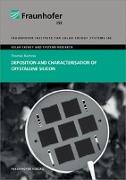- Start
- Deposition and Characterisation of Crystalline Silicon
Deposition and Characterisation of Crystalline Silicon
Angebote / Angebote:
The presented thesis will discuss the recent development in the deposition of silicon by atmospheric pressure chemical vapour deposition (APCVD) and the characterisation of these crystalline silicon thin films at Fraunhofer ISE.
In the second Chapter a short overview of the process technologies for chemical vapour deposition (CVD) will be given. A general and a simplified model for the silicon deposition will be discussed. Furthermore, the rapid thermal deposition tool and the standard deposition process will be described. This includes the influence of critical process parameters, the mechanism of doping incorporation and the deposition of epitaxial emitters.
One main objective of this thesis, the silicon deposition at a temperature from 1100 °C to 850 °C by APCVD, will be described in Chapter 3. The different properties of epitaxial and microcrystalline growth will be identified. A description of the process optimisation and a detailed process characterisation will be given.
In the 4th chapter the fundamentals of crystal growth, the formation of crystal defects and the characterisation of these defects, will be used to improve the silicon deposition by APCVD. The focus will be on the crystallographic characterisation by X-ray diffraction, electron backscatter diffraction, Raman spectroscopy and photo luminescence. Using these characterisation methods the material quality depending on process parameters and the growth interface of crystalline silicon thin films will be investigated.
The electrical characterisation of these layers will be the main subject in Chapter 5. More specific, the determination of the effective minority carrier lifetimes of silicon thin films and silicon wafers after the deposition process will be presented and discussed. The characterisation is primarily based on microwave photo conductance decay and quasi steady state photo conductance measurements.
I After the process development and the material characterisation, the fabrication and analysis of solar cells with silicon thin films will be presented in Chapter 6. The critical properties and the optimisation of the p-type solar cell concepts as well as the introduction of a n-type solar cell will be evaluated. The presented solar cell results, with silicon thin films deposited at deposition temperatures below 1050 °C, will also help to determine the critical parameters for further improvements.
In Chapter 7 another main objective the application of silicon epitaxy for the emitter formation is presented. The analysis includes a comparison between epitaxial and diffused emitters, a simulation of different emitter profiles and the formation of selective epitaxial emitters. Furthermore, solar cell results will be discussed to evaluate the limitations and the potential of epitaxial emitters.
In the last chapter the presented work will be summarised. Additionally, the experimental findings and main results will be presented. The final conclusion and an outlook for further experiments will complete the thesis.
Libri-Titel folgt in ca. 2 Arbeitstagen

